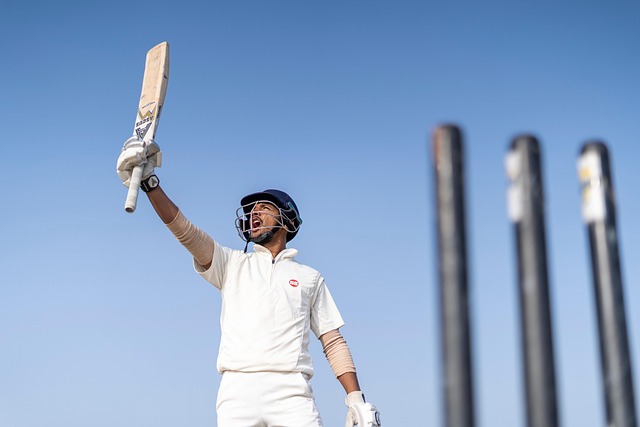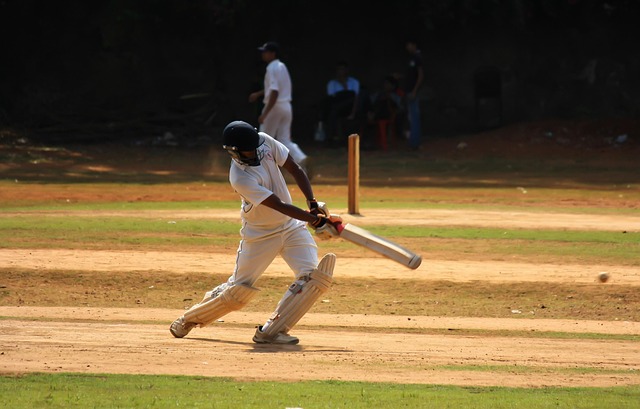The West Indies Cricket Team enhances performance through tailored Key Performance Indicators (KPIs) focusing on athletic prowess and defensive skills. The West Indies Cricket Board's player development programs emphasize technical, tactical, and mental resilience training. The West Indies Premier League (WIPL) utilizes advanced analytics, tracking software, and comprehensive data collection for detailed player and team analysis. Fielding metrics, batting statistics, and machine learning-driven analytics all play vital roles in evaluating and improving the West Indies cricket team's performance both domestically and internationally.
Uncover the secrets behind elite performance in the West Indies Premier League (WIPL) with our comprehensive guide. For the West Indies cricket team, tracking player metrics is key to dominance on the field. This article explores the art of assessment, from traditional statistics like batting runs and bowling wickets to advanced analytics leveraging machine learning. By delving into data collection methods and incorporating fielding metrics, we provide a holistic view of player prowess, ensuring optimal strategies for success in the WIPL.
- Understanding Key Performance Indicators for West Indies Cricket Team
- Data Collection Methods in W IPL Matches
- Analyzing Batting Statistics: Runs, Hits, and Average
- Bowling Performance: Wickets, Economy Rate, and Strike Rate
- Incorporating Fielding Metrics into Player Assessment
- Advanced Analytics: Machine Learning for Improved Insights
Understanding Key Performance Indicators for West Indies Cricket Team

For the West Indies cricket team, tracking player performance involves understanding and measuring Key Performance Indicators (KPIs) that align with the specific demands of the game. These KPIs go beyond individual batting or bowling averages to capture holistic aspects of a player’s contribution. For instance, diving catches exemplify the athletic prowess and defensive skills crucial in West Indies cricket history, where the team is renowned for its dynamic fielding. Beyond this, the West Indies women’s national team history highlights the importance of diverse metrics, including run-scoring rates, strike rates, and field placement efficiency, to assess performance across different formats.
Player development programs organized by the West Indies Cricket Board (WICB) play a vital role in fostering these KPIs. By visiting us at Player development programs West Indies cricket board anytime, players can access tailored training sessions aimed at enhancing their technical skills, tactical awareness, and mental resilience. These initiatives not only help track individual progress but also ensure that the West Indies cricket team remains competitive on both domestic and international stages.
Data Collection Methods in W IPL Matches

The West Indies Premier League (W IPL) offers a unique opportunity to track and analyze player performance across various cricket grounds in the region. Data collection methods play a crucial role in understanding the strengths and weaknesses of the West Indies cricket team. Traditional scouting reports and eye-based assessments are supplemented by advanced analytics, such as tracking software that captures player metrics during matches. For instance, at St. George’s Park in Grenada, technology is employed to record ball speed, bounce, and spin, providing valuable insights into the effectiveness of bowling actions.
These data collection methods extend beyond individual performances to consider team dynamics and strategic decisions. By analyzing match outcomes, we can identify patterns that contribute to memorable victories for the West Indies cricket team throughout their history. The W IPL acts as a crucible where players from the West Indies women’s national team history showcase their skills, with some even leaving their mark on these historic cricket grounds. For those interested in learning more about this dynamic, give us a call at West Indies women’s national team history to explore further how data is shaping the future of West Indies cricket.
Analyzing Batting Statistics: Runs, Hits, and Average

Analyzing Batting Statistics is a crucial aspect when tracking player performance in the West Indies Premier League (WIPL). Key metrics to consider include runs scored, hits made, and batting average. Runs are a fundamental measure of offensive success; players with higher run totals indicate stronger contributions to their team’s score. Hits, on the other hand, showcase the number of times a batter reaches base safely, demonstrating consistent contact and strategic selection. A player’s batting average, calculated by dividing runs scored by at-bats, provides insight into their overall hitting effectiveness. By examining these statistics, fans and analysts can identify top performers within the West Indies cricket team, whether men’s or women’s cricket.
In the WIPL, where international players often grace the pitches alongside local talent, understanding these numbers is vital. For instance, a player with a high average despite relatively fewer runs could indicate consistent performances, while a batter amassing numerous boundaries might be seen as a game-changer, especially in fast-paced Twenty20 formats. These insights can guide team strategies and even influence fan engagement, such as following the shoes worn by West Indies players or tuning into radio broadcasts of matches at iconic venues like Lal Bahador Stadium, Guyana, or visiting the cricket museum in the Caribbean to learn more about the sport’s rich history.
Bowling Performance: Wickets, Economy Rate, and Strike Rate

In the West Indies Premier League (WIPL), tracking player performance is crucial, especially for the bowling unit. Each bowler’s effectiveness can be measured by three key statistics: wickets taken, economy rate, and strike rate. Wickets are a direct indicator of success, with more wickets signifying better bowling performances. The economy rate, calculated by dividing runs conceded by overs bowled, reveals a bowler’s efficiency in containing the opposition. A lower economy rate indicates superior control over their deliveries. Strike rate, on the other hand, measures the number of runs conceded per over and is an essential metric to gauge how often a bowler disrupts the batters’ rhythm.
These metrics offer valuable insights into the performance of West Indies cricket team bowlers, helping coaches and analysts make informed decisions. For instance, a bowler with a high wicket count but a moderate economy rate might be a consistent threat who sacrifices some cost for increased dismissals. Conversely, a player with an impressive economy rate could indicate a skilled bowler who efficiently contains runs while still contributing to the team’s success. Understanding these nuances allows for strategic adjustments during matches and provides a platform to celebrate cricket legends from the West Indies and the iconic shoes they wear, as well as promote women’s cricket in the region. Even the vivid radio broadcasts of West Indies matches can’t match the thrill of witnessing these performances firsthand, so be sure to visit us at any time to experience the pulse of West Indies cricketer uniforms on display.
Incorporating Fielding Metrics into Player Assessment

In evaluating player performance in the West Indies Premier League (WIPL), incorporating fielding metrics is essential, especially when considering the rich cricket history of the West Indies team. Beyond batting averages and bowling figures, assessing a player’s impact on the field can provide a holistic view of their contribution to the overall success of their side. Metrics such as catch percentage, run-out instances, and direct hits offer valuable insights into a player’s agility, reaction time, and strategic positioning on the field. These metrics are crucial in understanding the tactical role players play in modern West Indies cricket, where teams often innovate to gain an edge, much like how shoes worn by West Indies players have evolved over the years to meet the demands of varying playing conditions.
For instance, a fielder with a high catch percentage might indicate exceptional hand-eye coordination and the ability to read shots, while a player who regularly contributes to run-outs showcases excellent field positioning and tactical awareness. By integrating these fielding metrics into performance assessments, coaches and analysts can better guide player development and inform strategic decisions. This approach aligns with the growing global interest in cricket, including increased TV coverage of Caribbean tournaments and the expanding reach of women’s cricket in the West Indies. To gain a deeper understanding of player performance, fans and enthusiasts are encouraged to explore cricket statistics for the West Indies team through various online platforms, even supporting local youth cricket initiatives by finding us at [West Indies youth cricket initiatives].
Advanced Analytics: Machine Learning for Improved Insights

In the dynamic landscape of cricket, advanced analytics powered by machine learning has emerged as a game-changer, particularly in the West Indies Premier League (WIPL). By leveraging sophisticated algorithms and vast datasets, teams can gain unprecedented insights into player performance. This data-driven approach allows for more informed decisions about team composition, tactical adjustments during matches, and personalized training programs tailored to individual needs.
For instance, analyzing historical data on the fastest bowler in West Indies history or exploring cricket rules and regulations explained through advanced analytics can reveal hidden trends and strengths. Radio broadcasts of West Indies matches, visits to iconic cricket grounds, and even tracking the highest run scorer for West Indies can contribute to a comprehensive understanding of the game. These insights not only enhance on-field performance but also captivate fans by showcasing the strategic depth within the WIPL. Give us a call at your earliest convenience to learn more about how these advanced analytics are revolutionizing cricket in the West Indies.
The West Indies Premier League (WIPL) offers a platform to showcase the prowess of the West Indies cricket team, and efficient player performance tracking is key to unlocking their potential. By employing a combination of traditional data collection methods and advanced analytics, including machine learning, we can gain valuable insights into each player’s contribution. This comprehensive analysis enables coaches and scouts to make informed decisions, identify strengths and weaknesses, and optimize strategies for the team’s success on the global stage. Understanding and tracking these key performance indicators (KPIs) are essential steps in developing a competitive West Indies cricket team.







Leave a Reply